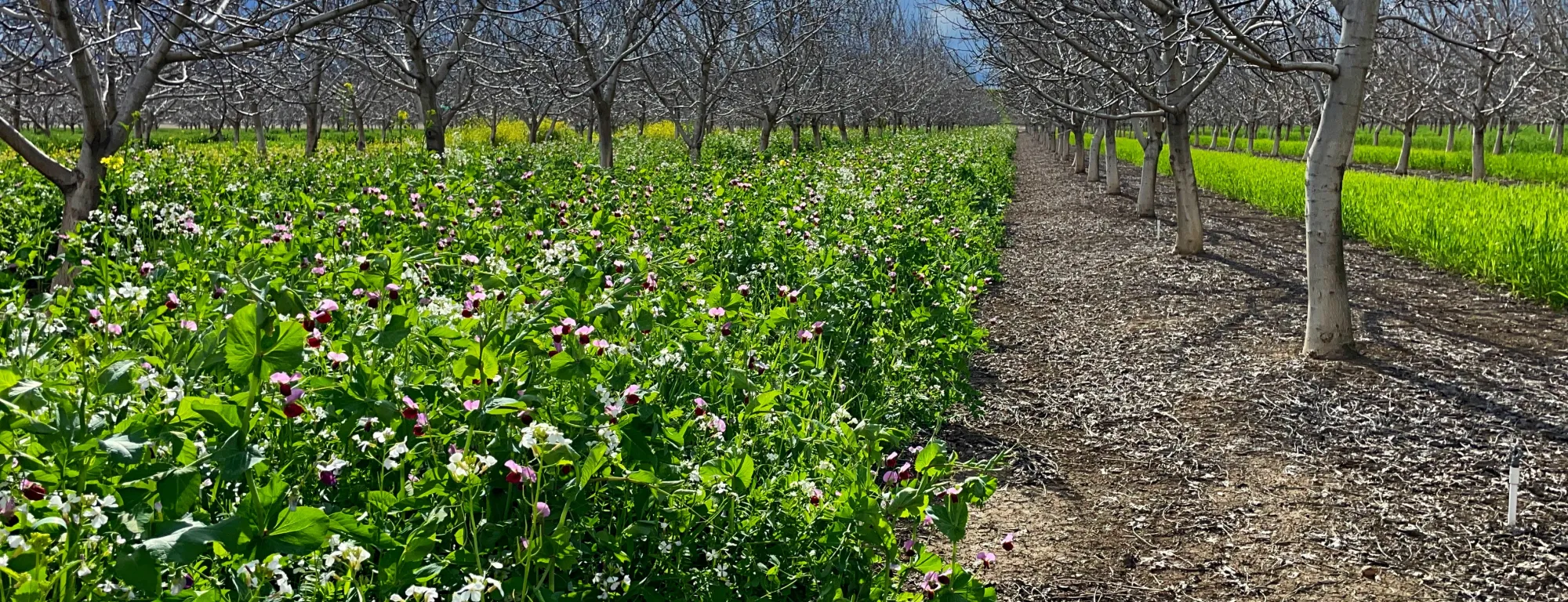
Where does the time go? Cover cropping season is upon us, again. After three years of running a cover trial in a walnut orchard in eastern Contra Costa County (at the northwestern reach of the San Joaquin Valley), there are some exciting results to share that could be helpful if you are deciding on what kind of cover crop to plant.
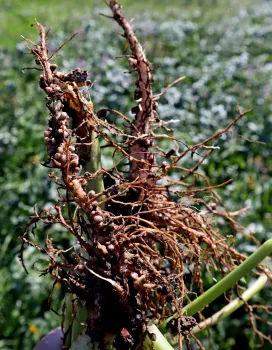
Why cover crop in orchards? But first, why plant a winter cover crop in an orchard at all? There are many benefits associated with cover crops growing in the orchard during the winter. Our main interest in running this trial was to see if we could improve water infiltration into the orchard ground, both through the winter rains and hopefully extending into the irrigation season (as this orchard is sprinkler irrigated). Vegetative cover will, in general, prevent soil crusting and allow water to absorb, and both the fibrous roots of grasses and the larger tap-roots of mustards and some legumes can produce larger channels going down to a significant depth. We also thought there might be some nutrient benefits by the cover crops mining existing nutrients and with legumes potentially providing extra nitrogen through nitrogen-fixation. We hoped also that we might see some general improvements in soil health and function with increased organic matter over the years. After three years, the results have been interesting and somewhat surprising.
The cover crop trial We included three different kinds of cover crop commonly used in walnut orchards: a winter triticale ("triticale"), a low-growing grass that produces a lot of fibrous roots but limited above-ground growth, a mustard blend consisting of several species of mustard and radish ("mustards"), and a multi-species mix ("multi-mix") consisting of a custom blend of grass, mustard, and legume species (bell beans, common vetch, and field peas). These were planted in early November of 2022, 2023, and 2024 with a seed drill in a 10 ft. band in two adjacent orchard row middles at two parts of orchard for 16 total rows including unplanted controls, and depended entirely on rain for germination growth. Unplanted orchard middles were maintained next to the cover crop treatment rows in 2024 and 2025, but they were disked and harrowed pre-plant like other treatments. I established plots at five places along the planted rows from which to take samples for evaluating the growth and nutrients in the soil and in the cover crop.

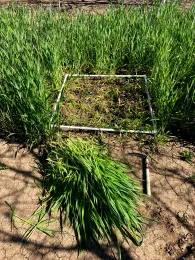
Cover crop biomass results In the spring, right around when the trees were leafing out in the first weeks of April, I sampled the aboveground vegetation from each cover crop treatment using a quadrat (a tool for collecting a standard sample from an equal area) just before the cover crop was terminated by mowing. The main outcome of the trial has been that the multi-mix with legumes consistently produced many times more aboveground biomass than the mustards or triticale (figure 1). It was interesting when at the end of the first season, it was obvious that the multi-mix had produced considerably more biomass than the other two treatments, but it has been very fascinating to see that pattern prove consistent across two more seasons. What's more, while there was a general trend toward less biomass being produced after the first year of the trial, the triticale and, especially, the mustards could be described as having grown rather poorly in 2024 and 2025. In those years, the multi-mix had 4 to 5 times as much aboveground mass. There were some differences in the amount and timing of rainfall each winter (something I hope to look at more closely, soon), but given that the multi-mix included legumes and we saw excellent nodulation (nodules on legume roots are where the bacterial symbiosis that facilitate the collection of nitrogen from the atmosphere takes place), could it be that added nitrogen during the cover crop season was a determinant in the differences in growth? (Nitrogen, an essential nutrient for the building blocks of proteins, is often a limiting factor on plant growth.)

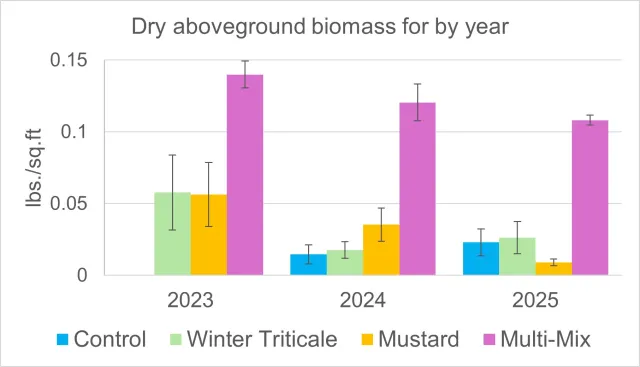
Plant nutrient analyses In fact, the nitrogen content of the multi-mix was considerably higher than the other cover crop types in both years (figure 2). These results were from the analysis of chopped cover crop samples from each plot right after the cover crop was mowed in April of 2024 and 2025. The carbon to nitrogen ratio, an analysis that indicates the amount of nitrogen relative to the total biomass, showed that, "pound for pound," the multi-mix had considerably more nitrogen than the other cover crop types, even though it produced so much more biomass overall (figure 3). The mustard mix seemed particularly bereft, which might explain why overall it grew thinly in 2024 and 2025.
Soil nutrient analyses Did the different cover crops result in different levels of important nutrients in the soil? Analysis of soil samples from the plots showed that in the spring, just before the cover crop was mowed, there was no difference between treatments, and the level nitrogen in the soil was quite low (figure 4). This is excellent, showing that the cover crops are probably holding most of what would have otherwise been free in the orchard soil at that point. Samples taken in July, though, show higher levels of nitrogen in the soil in the multi-mix plots compared with the other treatments, suggesting that the multi-mix cover crop did indeed contribute nitrogen to the soil during the growing season (figure 4). (It's worth pointing out that the difference showed up despite the fact that the whole orchard was fertilized through the irrigation system.) What was more surprising was that there was no difference in soil organic matter content across the different types of cover crop. Even the unplanted control was at a similar level to the cover crop treatments across the fall, spring, and summer sampling dates. Considering the differences in biomass produced in the different plots, this is very unexpected. One explanation may be that this is a sprinkler-irrigated orchard where the entire orchard floor is regularly wetted through the growing season, and the moisture allows the vegetation to decompose throughout the growing season. One benefit of this is that no residue that might interfere with harvesting nuts of the orchard floor is left at the end of the season. That said, the level of organic matter in this orchard even in November (around 2.5%) could be considered relatively high for California agricultural soils. It's even more interesting that soil organic matter did not measure differently in July, when there was still a mulch layer from the cover crop residue in the multi-mix rows which was substantially absent from the other treatments.
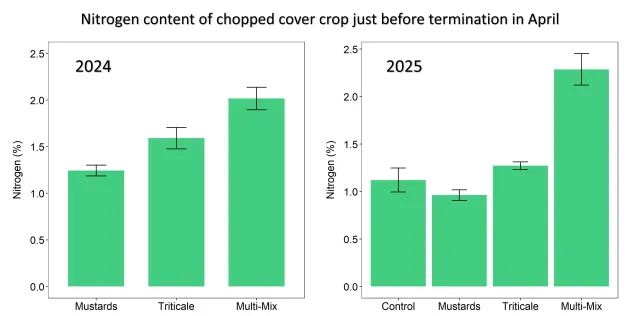
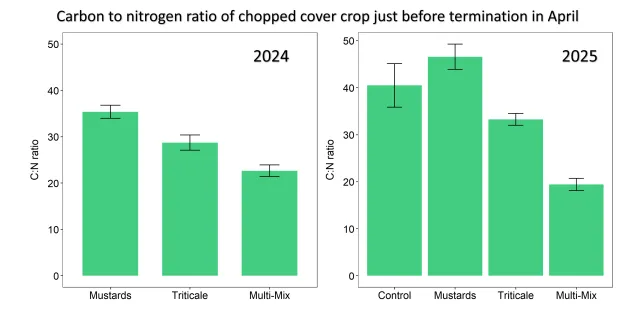
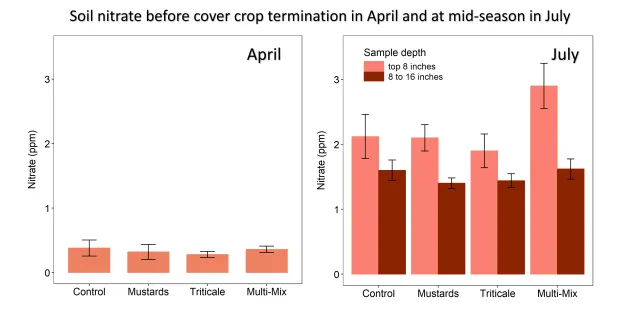
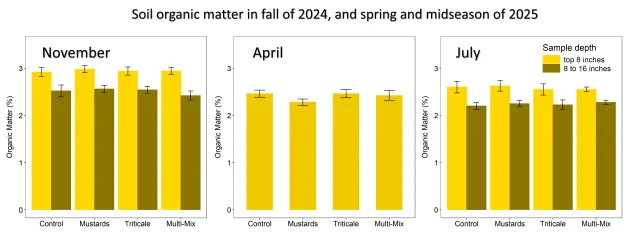
Conclusions It's important to recognize that a trial is limited in time and space, and that results could be very different in a different location or even at this site in different seasons. Triticale and mustards may perform better where nitrogen is less limiting. In fact, the mustards and grasses growing among the legumes in the multi-mix seemed much bigger than the same species corresponding cover crop type, suggesting that they somehow benefited from being in that company. That would be something to evaluate with analysis in future trials. Also, it seemed that dry January weather in 2025 may have particularly set the mustard back. With all that in mind, the idea of "hedging your bets" with a diverse mix seems to prove effective in this multi-year trial. Though the cost of seed is somewhat more for such a mix, it paid off in biomass and certainly delivered the most of the proverbial "bang for your buck."
Tempted to try cover crops in your orchard? If you are a grower in Alameda or Contra Costa county and interested in cover crops, feel free to reach out to discuss your interest and these results. My program also has a great number of cover crop related videos you can check out at the Mt. Diablo Region Crops UCCE YouTube channel, including one from a field day for this trial, and a series co-developed with the Resource Conservation District. Speaking of them, keep in my that the RCD and the NRCS (Natural Resource Conservation Service) can facilitate conservation grants, like the California Healthy Soils Program, that could defray the costs of cover cropping. You can also check my earlier post on the first year of the trial. I have a few new videos coming soon on this very cover crop trial, so stay tuned.
Acknowledgments This project was funded in part by a grant from the California Walnut Board & Commission. Kamprath Seed Company (Manteca, CA) generously provided seeds. Tom Johnson selected seeds and rates and helped to plant the trial and presented at field days and for video shoots. Thanks to Long Shadow Farm (Byron, CA) for collaboration and hosting the trials.
Sources and References:
Cover Cropping Opportunities in Specialty Crops video series by Contra Costa County Resource Conservation District and UC Cooperative Extension
Cover Crops for Walnut Orchards UC ANR Publication Number 21627e
Cover Crop Selection tool by UC ANR SAREP
Geisseler, Lazicki, and Horwath. Field-Specific Nitrogen Fertilization Adjustments (A resource for considering the nitrogen contribution of cover crops and other non-fertilizer sources.)
Grasses, Mustards, & Legumes: An Orchard Cover Crop Field Day video featuring Tom Johnson of Kamprath Seed by UCCE Specialty Crops in the East Bay/Mt Diablo Region
Mt. Diablo Region Specialty Crops on YouTube: www.youtube.com/@diabloregioncrops

